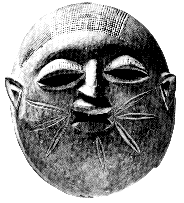
An engúngún mask collected in northern Yorubaland in 1912; from the collection of the Berlin Museum für Volkerkunde; reproduced in Frank Willett, African Art, Thames and Hudson, 172.

An engúngún mask collected in northern Yorubaland in 1912; from the collection of the Berlin Museum für Volkerkunde; reproduced in Frank Willett, African Art, Thames and Hudson, 172.
The child's point of view given voice by young Wole illuminates the contradictions and adaptations inherent in the meeting of religions and spiritual belief systems in a colonial society. In an exchange with his friend Osiki, a non-Christian child from outside the parsonage, Wole's understanding of the Christian traditions of his family and the non-Christian beliefs of the surrounding townsfolk meld the two into a new creation.
The stained-glass window behind the altar of St Peter's church displayed the figures of three white men, dressed in robes which were very clearly engúngún robes. Their faces were exposed, which was very unlike our own eg�ng�n, but I felt that this was something peculiar to the country from which those white people came. After all, Osiki had explained that there were many different kinds of engúngún. I sought his opinion on the three figures only to have Tinu interrupt.
"They are not engúngún," she said, "those are pictures of two missionaries and one of St Peter himself."
"Then why are they wearing dresses like engúngún?"
"They are Christians, not masqueraders. Just let Mama hear you." (32-33)
Wole's assumption that these Christian figures, meeting two eg�ng�n criteria of being dead and in robes, must be part of this non-Christian tradition arises from his position as a young child. However, his confusion and lack of understanding of the boundaries between the two belief systems underscores the adaptation and syncretic cultural production being performed by colonized people under a colonizer's political and cultural regime. Wole's age excuses his ignorance, but such mixtures of ideas and beliefs obviously shape the everyday life of both children and adults in Aké. Witness Wole's description of his Christian mother's claim that Wole's uncle Sanya is a supernatural being, and Wole's retelling of how the Rev. Ransome-Kuti drove off such beings into the woods, or how the eg�ng�n destroyed a church. Wole's conflation of Christian icons and native ancestral spiritual figures, in such a context, becomes illustrative of how belief systems clash and meld in order to survive the colonial condition.